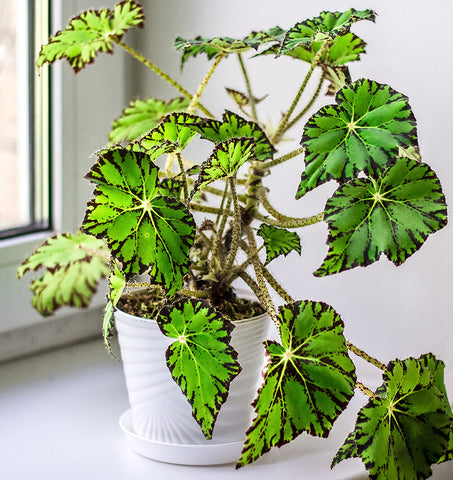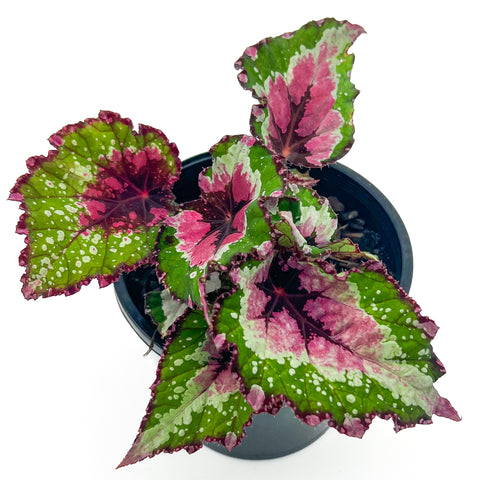Begonia Plant Care Guide
HOW TO GROW AND CARE FOR BEGONIAS

| Common Varieties | Polka Dot Begonia, Rex Begonia, Angel Wing Begonia, Cane Begonia, Dragon Wing Begonia, Iron Cross Begonia, and Begonia Maculata. |
| Botanical Name | Begonia spp. |
| Family | Begoniaceae |
| Plant Type |
Tropical rhizomatous perennial
|
| Mature Size | Varies by species, typically between 15-45 cm tall |
| Light | Moderate to bright, indirect light |
| Soil Type | Well-draining aroid mix |
| Native Areas | Tropical and subtropical regions worldwide |
| Toxicity | Generally non-toxic to dogs and cats, but may cause mild gastrointestinal upset if ingested in large quantities. |
Growing Begonias indoors can be a rewarding experience for any home gardener. You'll need to find a well-lit spot in your home that gets bright, indirect sunlight. It's best to avoid direct sunlight, as it can scorch their leaves. You'll also need to provide Begonia with a well-draining, light potting medium. When watering, ensure the potting medium is evenly moist and not waterlogged, as this can lead to root rot. During the growing season, you'll want to fertilise your Begonia every 2-3 weeks with a balanced, liquid fertiliser such as the Growth Technology, Orchid Focus. Begonias are tropical plants that thrive in warm temperatures, and moving them away from cold drafts in the cooler months will ensure your plants will thrive indoors for many years.
Our general Begonia care guide will provide all the information you need to keep your Begonias healthy and thriving. We will give you tips on their light requirements, temperature needs, watering and fertilising, and how to propagate your plant. Let's embark on the journey of Begonia plant care together!
WELCOME TO YOUR COMPLETE GUIDE TO CARING FOR BEGONIAS

HOW MUCH LIGHT DOES A BEGONIA NEED?
Begonias are among the most popular houseplants due to their ability to thrive in various indoor environments. They do best in bright, indirect light for most of the day and should be protected from direct sunlight, which can burn their leaves. You will notice if your plant is not getting enough light, as it may become leggy and lack flowers.
HOW OFTEN SHOULD I WATER A BEGONIA?
It depends on your environment, but you may need to water once a week depending on its environment. Allow the top few centimetres of the soil to dry out between watering sessions. They like consistent watering and to be kept slightly moist but not wet. Make sure the pot has drainage holes so excess water can drain out. During the winter months, the plant may need less water. If the leaves turn yellow or curl, the plant will likely get too much water. Keep the water off the foliage as it can wilt the leaves. Bottom watering is a great way to water Begonia to protect their foliage.
HOW TO WATER BEGONIAS IN THE WINTER
During the winter, it's essential to keep your begonia plants hydrated. The best way is to water them when the top few centimetres of soil is dry. Depending on the size of your plant and its pot, this may be once a week or more often. When you do water, ensure the soil is moist but does not keep your plant soggy. If your Begonia looks wilted, it indicates that it needs water.
WHAT IS THE BEST POTTING MEDIUM FOR BEGONIA?
A well-draining and light soil mix is ideal for begonias. A medium containing equal parts of peat moss, premium potting mix and perlite is perfect for begonias. Adding a small amount of compost or aged manure will also provide some extra nutrients to the soil. If the soil mix is too heavy, it could lead to root rot and other issues.

WHAT IS THE BEST TEMPERATURE FOR BEGONIA?
The best temperature for begonias growing indoors is between 18-23°C. Begonias prefer temperatures with some fluctuation during the day and night. They can tolerate temperatures up to 27°C for short periods, but temperatures above this can cause the plant to become stressed. Begonias should not be exposed to temperatures below 10°C as this will cause them to go dormant.
WHAT IS THE BEST HUMIDITY FOR BEGONIA?
The best humidity for Begonias growing indoors is generally average room humidity between 50-60%. This humidity level will help the plant stay healthy and prevent it from becoming too dry. Begonias prefer a slightly humid environment, so monitoring the humidity levels and adjusting them when necessary is essential. Additionally, it is important to ensure that the plant is placed in an area with good air circulation. With the right humidity and proper care, your Begonias should thrive!
WHAT'S THE BEST FERTILISER FOR BEGONIA?
Initially developed for the Kew Royal Botanic Gardens in London, GT Orchid Focus is the international go-to for Begonia growers. It's the best product to promote healthy growth and beautiful blooms.
Growth Technology Orchid FocusIncludes calcium at higher levels hoyas need to prevent deficiencies. Free of chlorides! High-salt fertilisers are not good for Begonias.
- Urea-free! Using urea as the nitrogen source, the
 risk of fertiliser burns increases.
risk of fertiliser burns increases. - PH of 6 which emulates the slightly acidic pH most hoya prefer.
- Contains all 12 essential minerals, at the correct levels Begonias require to thrive.
WHAT ARE COMMON BEGONIA PESTS, AND HOW DO YOU TREAT THEM?
Begonias are susceptible to various pests, including aphids, mealybugs, spider mites, and whitefly. To treat these pests, first remove any visible pests with a cotton swab dipped in rubbing alcohol. Then, apply insecticidal soap or horticultural oil to the plant. Be sure to cover all the foliage to ensure all pests are killed. If the infestation is severe, you may need to use a chemical insecticide, such as permethrin. Always follow the instructions on the product label and take all necessary safety precautions. Additionally, beneficial insects such as ladybugs, lacewings, parasitic wasps and parasitic mites can be effective biological control against these pests.
You can purchase them from Bugs for Bugs: https://bugsforbugs.com.au/

HOW TO PRUNE A BEGONIA
Pruning a begonia is a great way to maintain the plant's health and encourage new growth. Start by removing any dead or damaged stems, leaves and flowers. Next, use sharp scissors or pruning shears to trim off any stems or leaves growing in an overcrowded or unruly manner. Ensure you don't cut back too far, as it may shock the plant. If you're looking for a more formal look, you can also prune off any stems more than one-third of the way up the plant. After pruning, providing your Begonia with the proper care, such as plenty of sunlight and adequate water, is crucial. Pruning your Begonia regularly will help to keep it looking healthy and vibrant.

HOW TO PROPAGATE A BEGONIA
Begonias can be propagated by taking stem, leaf, or rhizome cuttings.
Stem Cutting: Cut off 10cm or so of the stem with some leaves. Let the cut area callus over, then partially submerge the stem in water, leaving the leaves sticking out. Place the glass containing the cutting in a light and warm spot. Avoid placing it in full sun as the cutting will wilt and die. When your cutting has rooted in the water, use a mix of peat moss-based light potting medium and perlite to pot up the new plants and keep them slightly moist. They might go into shock, but after a few days, they will adjust and keep growing. If you want to propagate directly into the soil, use the same soil mix as above, and plant your cuttings into small pots to approximately half the way up the stem. Keep your soil slightly moist and place it in a warm position out of direct light.
Leaf Cutting: When taking a leaf cutting, cut a healthy, large leaf at the point where it meets the leaf stem. Locate the petiole (The area where the leaf connects to its leaf stem), and pip it into the rooting hormone. Plant the leaf in the soil so the petiole is covered and the rest is exposed. Keep moist and in a bright, indirect light in a warm position, and you should have plantlets growing in no time. You can use this method with partial leaves too. Just make sure you callus the cuts before planting into the soil.
Rhizome cutting: Cut the rhizome of a Rhizomatous Begonia into 5cm long pieces. Ensure they have growth nodes so they can grow leaves and roots. Place the rhizome horizontally on the soil and push them, so they're about halfway covered. Place in indirect light in a warm spot and keep the soil moist.
Begonia's cuttings can grow in most mediums from water propagation, soil propagation, sphagnum moss, perlite or vermiculite. Go with the method that is most comfortable for you.
When should I repot a Begonia?
Begonias should be re-potted when the plant's roots have filled the pot. If the roots are tightly wound inside the pot, sticking out the bottom of the drainage holes, or the plant is top-heavy and outgrowing the pot, it's likely time for repotting. Additionally, it may be time for a new pot with fresh soil if it has been several months since the Begonia was last re-potted. Repotting a begonia is vital for its health and growth, as it will give the plant more room for its roots to spread out and access the nutrients in the soil.
WHAT SORT OF POTS DO BEGONIA LIKE?
Begonias prefer shallow pots as their roots don't require a very deep pot. Ceramic or plastic pots are great, ensure they have a drainage hole and sit on a saucer. If you wish to use decorative pots, make sure your plant never sits in water, or they will rot.
HOW DO YOU GET A BEGONIA TO BLOOM?
Providing your plant with the right growing conditions will keep your plant happy. Place it in a spot with bright, indirect sunlight and keep the temperature between 15-20 C. Water when the top few centimetres of soil is dry. Feed your Begonia with a balanced fertiliser every two weeks to give the plant the necessary nutrients for healthy growth and blooming. Finally, deadhead any spent flowers to encourage new blooms and give your Begonia a little extra pruning to maintain its shape. With the proper care and attention, you should have a vibrant blooming begonia in no time.
ARE BEGONIAS TOXIC TO PETS AND CHILDREN?
Yes, Begonias can be toxic to pets and children.

Popular Begonia varieties
Rex Begonia (Begonia rex) - known for its beautiful, textured leaves with vibrant colours and patterns.
Iron Cross Begonia (Begonia masoniana) - named for the distinctive cross-shaped pattern on its leaves, this variety is prized for its unique appearance.
Angel Wing Begonia (Begonia coccinea) - has long, slender leaves with pointed tips and clusters of delicate flowers in shades of pink, red, and white.
Rhizomatous Begonia (Begonia rhizomatous) - known for its large, waxy leaves in shades of green, silver, and burgundy, this variety can grow quite large and is a favourite among collectors.
Cane Begonia (Begonia 'Angelica') - has long, woody stems with clusters of delicate flowers and shiny green leaves.
